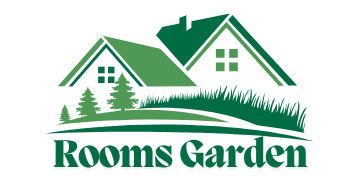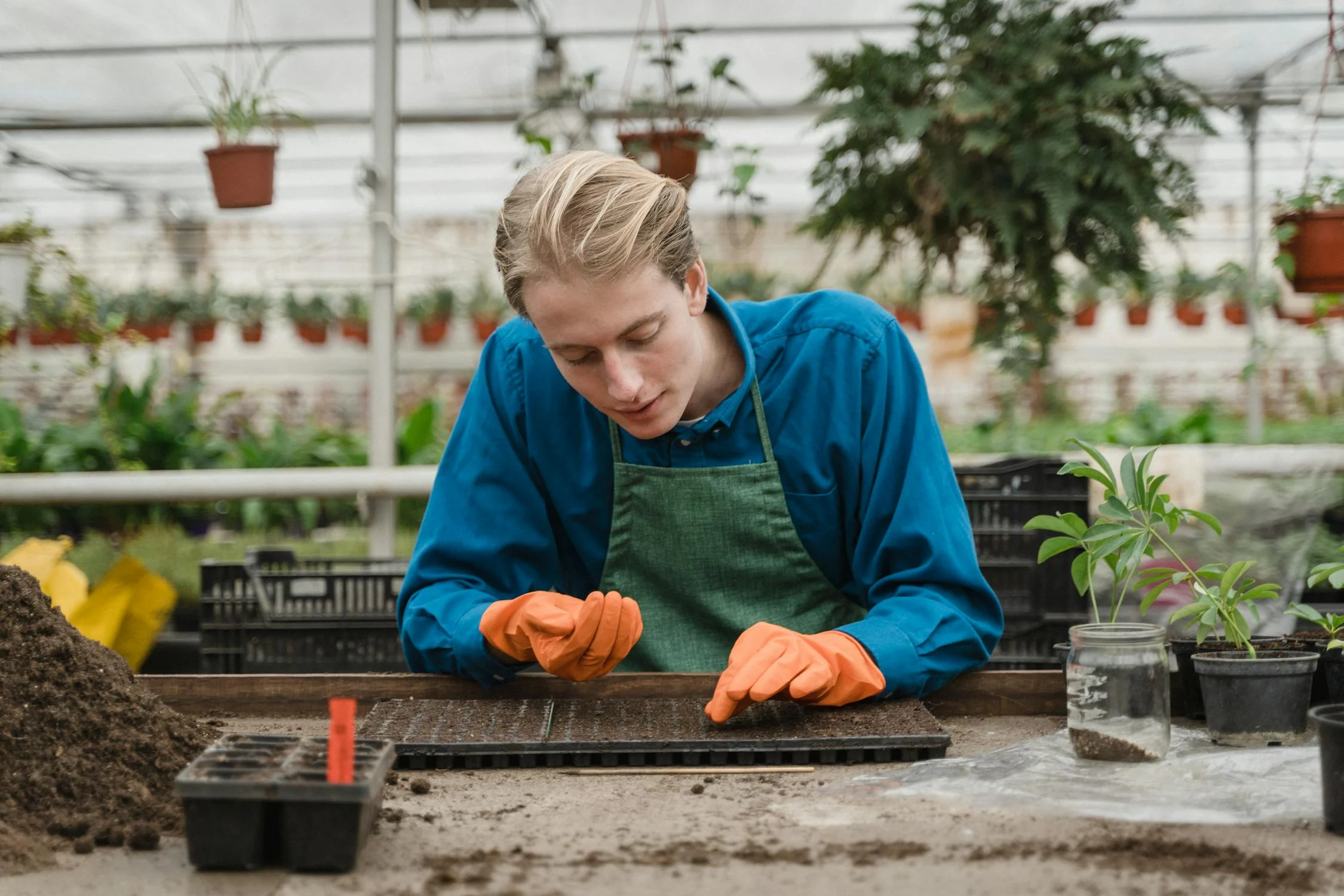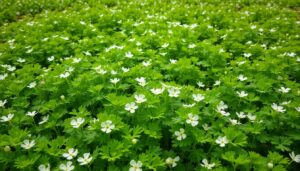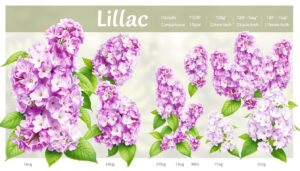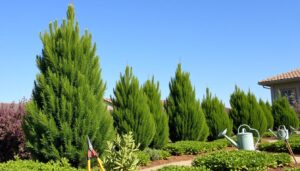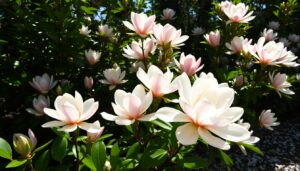Standing in my backyard, I admired the lush grass. It was a sight to behold. Perennial ryegrass was the secret to my lawn’s beauty. It’s a cool-season grass known for its quick growth and vibrant green color.
Whether you’re new to gardening or love lawns, growing perennial ryegrass is rewarding. This guide will cover everything from its characteristics to how to care for it. You’ll learn to create a lawn that’s both beautiful and resilient.
Table of Contents
Understanding Perennial Ryegrass Characteristics
Perennial ryegrass, known as Lolium perenne, is a favorite for lawns. It’s known for being hardy and easy to care for. This makes it a great choice for many landscapes.
Physical Features and Growth Patterns
Perennial ryegrass has fine blades that grow close together. It does well in cool weather, from 40°F to 94°F. It also likes well-draining soil, making it versatile for many areas.
Climate Tolerance and Adaptability
This grass is very good at handling different climates. It thrives in both cool and warm weather. Its ability to grow in various soils also makes it popular.
Benefits for Your Landscape
Perennial ryegrass is great for many reasons. It’s tough and can handle a lot of foot traffic. It also helps prevent soil erosion on slopes. Plus, it’s good for overseeding warm-season grasses in transition zones.
Perennial ryegrass is a top choice for lawns. Its unique traits, like its physical appearance and climate adaptability, are big pluses. Knowing these can help you pick the best grass for your lawn.
Best Time to Plant and Climate Considerations
The best time to plant cool-season grass, like perennial ryegrass, is late summer to early fall. This is usually from August to September. It lets the lawn grass grow strong before winter. In warmer places, you can also plant in early spring.
Perennial ryegrass grows well in mild summers and cool winters. It’s perfect for the northern United States and areas in between.
In the Upper South, dormant seeding is best from late November to early February. Soil should be below 40°F. Use more grass seed than recommended for the best results. Lightly mist the area with about 0.10 inches of water after sowing.
Seeds start to grow when soil is between 50 to 65°F. This matches air temperatures of 60 to 75°F. Mist the area every day for 10 to 14 days after germination. Use a starter fertilizer to feed the new grass.
Cool-season grasses like fescue and ryegrass do well in cooler weather. Plant them in late summer to early fall. Warm-season grasses, such as Bermuda and Zoysia, need warm air and soil. Plant them in late spring to early summer.
| Grass Type | Germination Time |
|---|---|
| Perennial Ryegrass | 5 – 10 days |
| Fine Fescue | 7 – 14 days |
| Tall Fescue | 10 – 14 days |
| Centipedegrass | 14 – 21 days |
| Kentucky Bluegrass | 14 – 30 days |
| Bermudagrass | 10 – 30 days |
| St. Augustinegrass | 10 – 30 days |
| Zoysiagrass | 14 – 21 days |
Seeding times vary by region. Colder areas plant in fall, while warmer ones plant in spring. For seeds to grow well, they need water, sunlight, stable temperatures, and good soil.
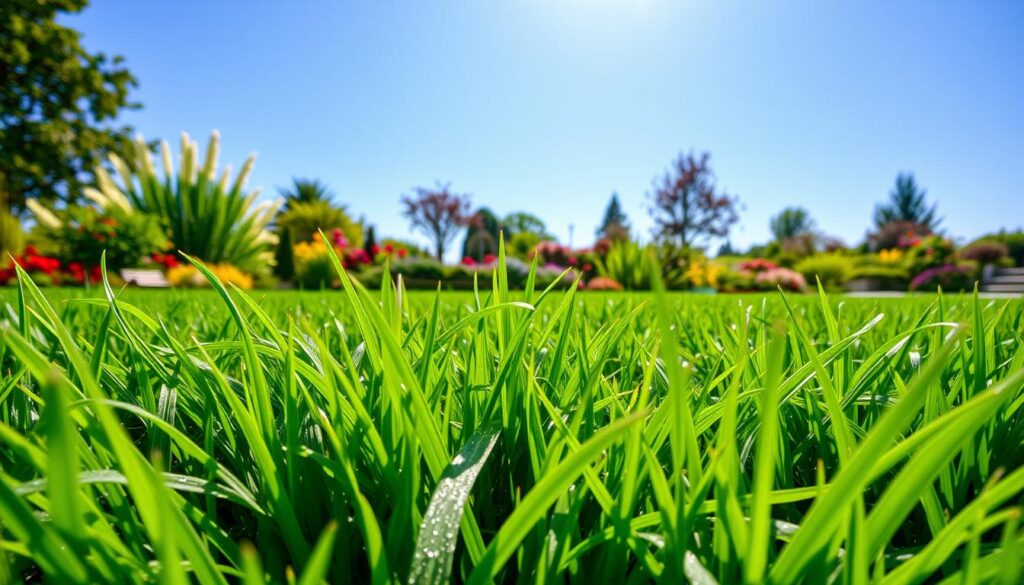
Soil Preparation and Testing Requirements
Starting a lush, healthy lawn begins with good soil preparation. Perennial ryegrass, a key part of many beautiful lawns, grows best in well-draining, fertile soil. The soil’s pH should be between 6.0 and 7.0. Before planting your grass seeds, it’s important to do a soil test. This test checks the soil’s nutrient levels and acidity.
Ideal Soil Conditions
Perennial ryegrass loves soils rich in organic matter and balanced nutrients. The best soil is well-aerated and has a loose, crumbly texture. This texture lets roots grow easily. Also, good drainage is key to avoid waterlogging and diseases.
pH Levels and Nutrients
The pH level of your soil is very important. It affects how nutrients like nitrogen, phosphorus, and potassium are available to your grass. Aim for a pH between 6.0 and 7.0. If the test shows your soil’s pH is off, you can fix it with lime or other pH adjusters.
Ground Preparation Steps
- Remove any debris, rocks, or existing vegetation from the area you plan to seed.
- Loosen the top 2-3 inches of soil using a rototiller or garden fork to create a smooth, level surface.
- Incorporate organic matter, such as compost or well-rotted manure, into the soil to improve its structure and nutrient content.
- Ensure the ground is properly graded to promote efficient drainage and prevent water pooling.
By preparing your lawn’s soil well, you’ll give your perennial ryegrass the best chance to thrive. This will lead to a lush, vibrant lawn that will impress your neighbors.
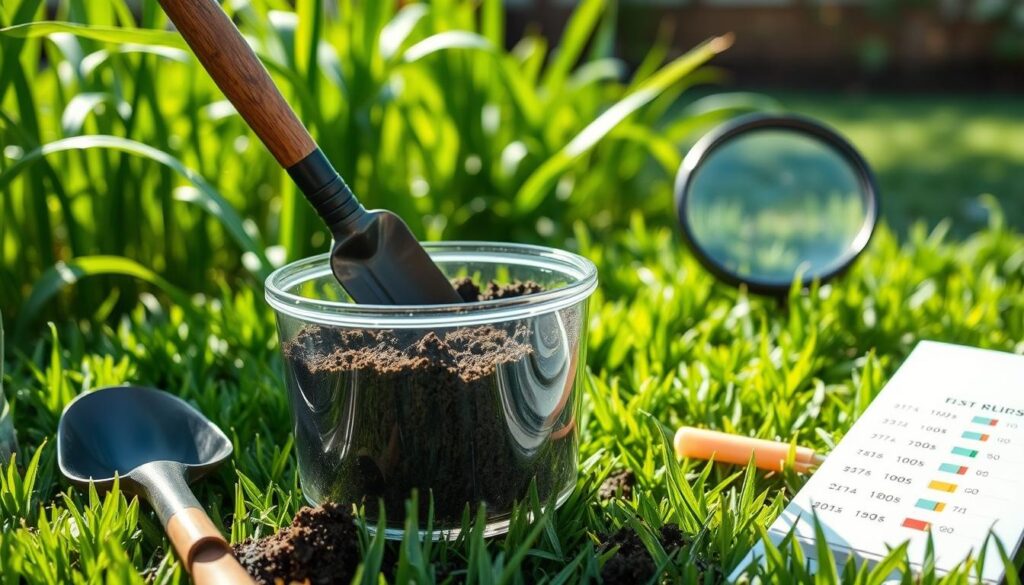
Seeding Techniques and Application Methods
Starting a lush, healthy lawn grass lawn begins with the right grass seed application. Whether you’re starting a new turf grass lawn or adding to an existing one, knowing the best seeding methods is crucial. It helps you achieve the lawn you want.
For a new lawn grass lawn, spread 6-8 pounds of grass seed per 1,000 square feet. If you’re overseeding, use 3-4 pounds per 1,000 square feet. A seed spreader helps spread the seed evenly over the area.
- After spreading the grass seed, lightly rake the soil. This ensures the seeds make good contact with the soil.
- On slopes, use erosion control blankets or hydroseeding to keep the seed in place.
- Cover the grass seed with a thin layer of soil or compost. This protects the seeds and keeps moisture in.
By using the right seeding techniques and paying attention to details, you can grow a thriving turf grass lawn. Follow these steps to create a lush, green space in your yard.
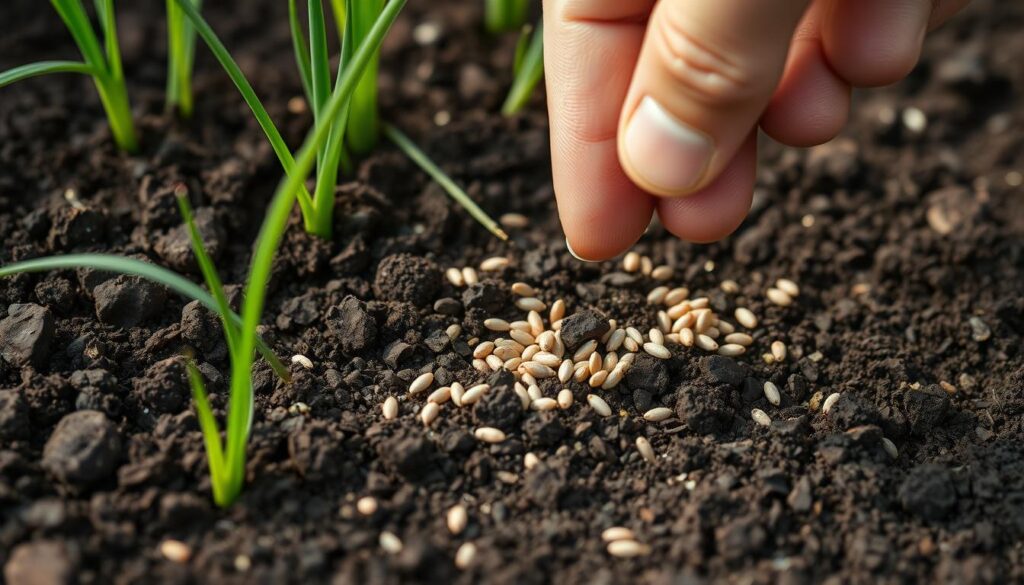
“The key to a successful lawn grass establishment is to mimic nature’s own seeding process as closely as possible.”
Watering Schedule and Requirements
Proper watering is key for a lush, healthy lawn care and landscaping with turf grass. During the initial seed germination phase, the soil must be kept consistently moist. This ensures the best results.
Initial Watering for Seed Germination
When starting a new lawn care or landscaping project with turf grass, water the seeded area 2 to 4 times daily. Use 5- to 10-minute sessions each time. This light and frequent watering prevents seeds from drying out and promotes rapid germination.
Perennial ryegrass germinates in 5 to 10 days. Keep up this watering until most seeds have sprouted, usually 10 to 14 days.
Established Lawn Irrigation Tips
Once the lawn care or landscaping turf grass is established, it needs about 1 to 1.5 inches of water per week. Water deeply and less often, aiming for 3 twenty-minute sessions per week. This encourages deep root growth and drought tolerance.
Seasonal Watering Adjustments
Adjust your lawn care or landscaping turf grass watering schedule with the seasons. Reduce watering in cooler months and increase it in hot, dry periods. This keeps the grass healthy and vibrant all year.
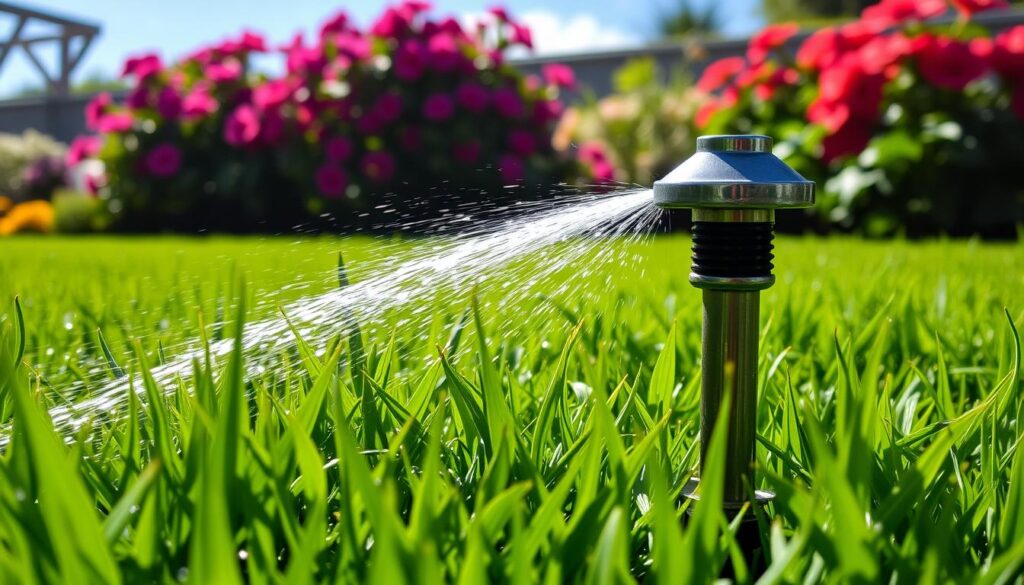
| Grass Type | Germination Time | Initial Watering | Established Watering |
|---|---|---|---|
| Bermudagrass | 10-30 days | 2-4 times daily, 5-10 min | 1 inch per week, 3 sessions |
| Kentucky Bluegrass | 14-30 days | 2-4 times daily, 5-10 min | 1 inch per week, 3 sessions |
| Perennial Ryegrass | 5-10 days | 2-4 times daily, 5-10 min | 1 inch per week, 3 sessions |
| Tall Fescue | 10-14 days | 2-4 times daily, 5-10 min | 1 inch per week, 3 sessions |
Maintenance and Mowing Guidelines
To keep your perennial ryegrass lawn looking great, follow a regular care routine. Mowing right and fertilizing on time are crucial. They help keep your grass lush and easy to care for.
Mow your perennial ryegrass to 1.5-2.5 inches tall. This height makes your lawn look neat and helps it stay moist. Never cut more than one-third of the grass blade length at once to avoid harming the plant.
Fertilizing your lawn is also key. Use a balanced, slow-release fertilizer in spring and fall. This supports the grass’s growth and keeps it green and strong all year.
Regular aeration and dethatching also help your lawn. These steps prevent soil compaction and thatch buildup. This improves water and nutrient absorption. Aim to aerate and dethatch every 1-2 years for the best results.
| Grass Species | Recommended Mowing Height |
|---|---|
| Perennial Ryegrass | 1.5 – 2.5 inches |
| St. Augustinegrass | 2.5 – 3 inches |
| Kentucky Bluegrass | 2 – 3 inches |
| Bermuda Grass (seeded) | 1 – 1.5 inches |
| Zoysiagrass | 0.5 – 1 inch |
By sticking to these lawn care, landscaping, and low-maintenance grass tips, your perennial ryegrass lawn will stay vibrant and healthy all year.
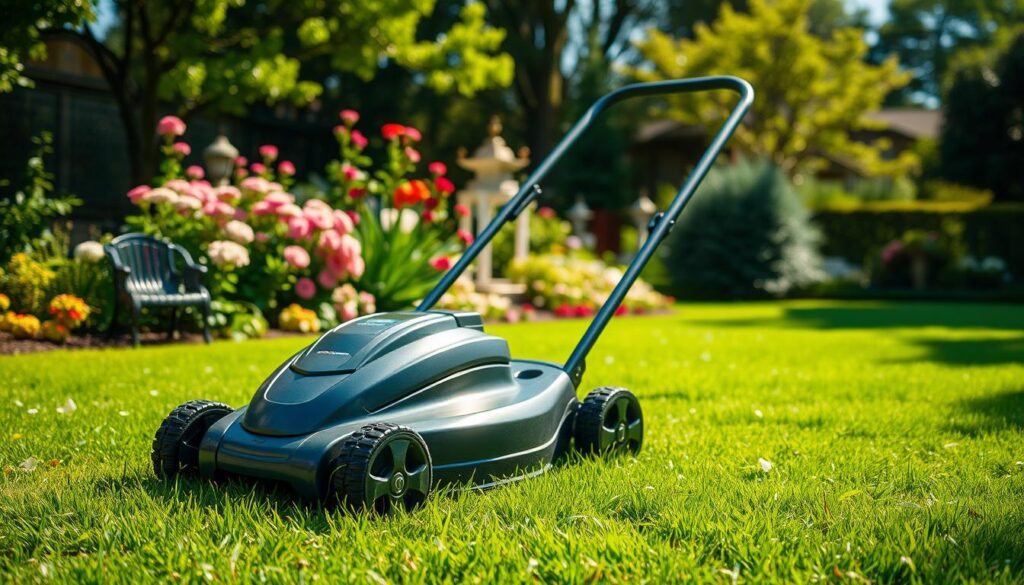
Dealing with Common Problems and Pests
Even with the best care, perennial ryegrass can face many challenges. Fungal diseases and pests are common issues. Knowing how to spot and fix these problems is key to a healthy lawn.
Disease Prevention
Fungal diseases like brown patch and gray leaf spot can harm perennial ryegrass. To avoid these, don’t overwater and keep the air moving. Regular mowing and the right fertilization also help the grass fight off diseases.
Pest Control Strategies
Grubs and armyworms can damage your lawn. If pests are a problem, use specific insecticides. But remember, these can harm good bugs too. Try natural solutions first.
Weed Management
A dense lawn is the best defense against weeds. Keep your lawn mowed and fertilized well. Use pre-emergent herbicides in spring to stop weeds. Also, treat any weeds that don’t go away.
By being proactive, you can keep your lawn looking great. It will stay lush and pest-free.
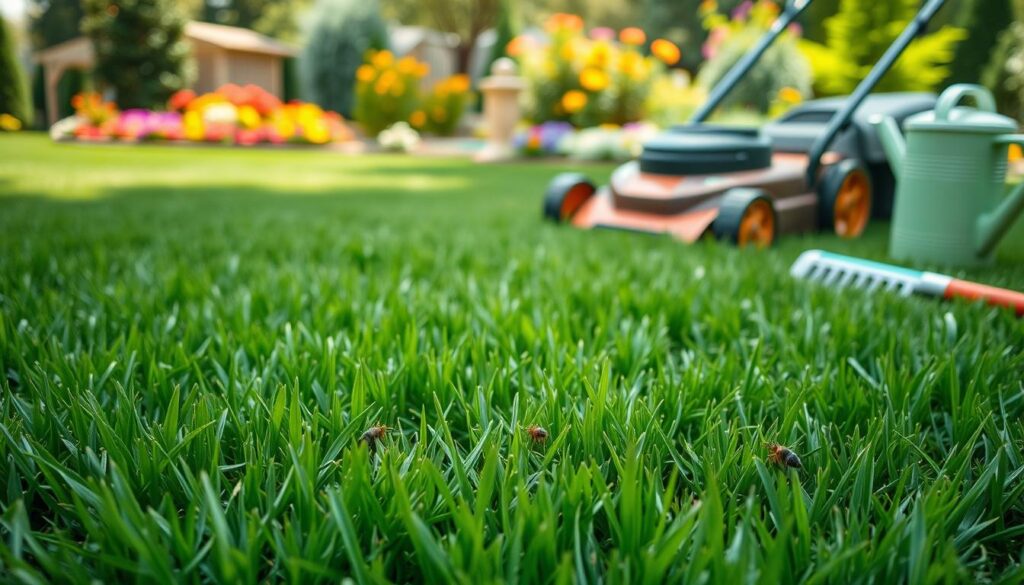
Seasonal Care and Overwintering Tips
As the weather cools down, your lawn care needs to change. This is especially true for cool-season grasses like perennial ryegrass or Kentucky bluegrass. By following these tips, you can keep your lawn looking great all year.
In the fall, start mowing a bit higher and use a winterizer fertilizer. This helps the grass’s roots grow stronger. Keep mowing until the grass stops growing, usually in late fall or early winter. Try not to walk on frozen grass, as it can harm the blades and crown.
When spring comes, lower your mowing height and use a light fertilizer to help the grass grow. In the summer, raise the height again to protect the grass from heat and dryness. Also, overseed in the fall to fill in any bare spots.
| Season | Lawn Care Recommendations |
|---|---|
| Fall |
|
| Winter |
|
| Spring |
|
| Summer |
|
| Year-round |
|
By following these seasonal lawn care tips, you can keep your cool-season grass lawn healthy and vibrant all year. Adjust your mowing, fertilizing, and overseeding to match the season.
Conclusion
Perennial ryegrass is a great choice for your lawn. It grows fast and is tough, perfect for cool seasons. With the right care, your lawn will be lush and green, even with lots of use.
Knowing how perennial ryegrass works is key. It has special features and grows in certain ways. Make sure to prepare the soil well and water it right to get the best results.
Keep an eye out for problems like pests and diseases. Quick action can prevent big issues. With good care, your lawn will stay beautiful for many years.
FAQ
What are the key features of perennial-ryegrass?
Perennial-ryegrass is a cool-season grass. It grows fast and is very durable. It looks lush green and has fine blades.
This grass grows in dense bunches. It’s good for many soils and can handle a lot of traffic.
What are the ideal climate conditions for growing perennial-ryegrass?
It loves cool weather and can handle 40-94°F. It’s best in the northern U.S. and areas with mild summers and cool winters.
When is the best time to plant perennial-ryegrass?
Plant it in late summer to early fall, from August to September. This lets it grow before winter. In warmer places, plant in early spring.
What are the ideal soil conditions for growing perennial-ryegrass?
It likes well-draining, fertile soil with a pH of 6.0 to 7.0. Test your soil to see if it needs adjusting.
How should perennial-ryegrass be seeded?
Use 6-8 pounds of seed per 1,000 square feet for new lawns. For overseeding, use 3-4 pounds. Spread the seed evenly and cover it lightly to keep it moist.
How often should perennial-ryegrass be watered?
Keep the soil moist during germination. Once it’s grown, it needs 1-1.5 inches of water a week. Water deeply but not too often.
How should perennial-ryegrass be mowed?
Mow it at 1.5-2.5 inches for a neat look. For better drought resistance, mow it up to 3-4 inches. Never cut more than one-third of the blade at once.
What are common problems and pests to watch for?
It can get fungal diseases like brown patch and gray leaf spot. Avoid overwatering and improve air flow to prevent this. Grubs and armyworms are pests that may need insecticides. Keeping the lawn dense helps with weeds.
How should perennial-ryegrass be cared for seasonally?
In fall, raise the mowing height and use a winterizer fertilizer. In spring, lower the height and fertilize lightly. In summer, raise the height to protect the grass. Overseed in fall to keep the lawn thick.
